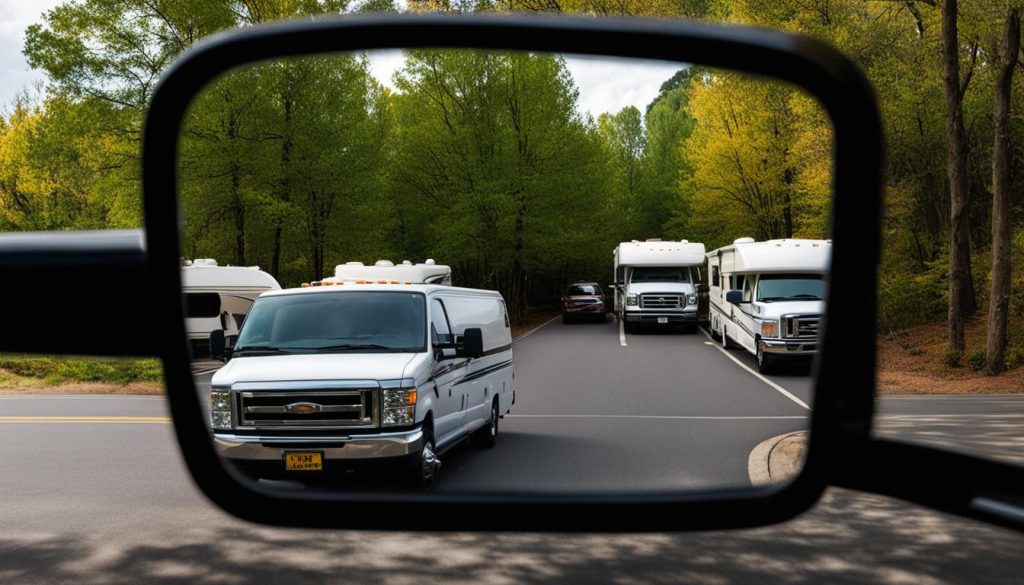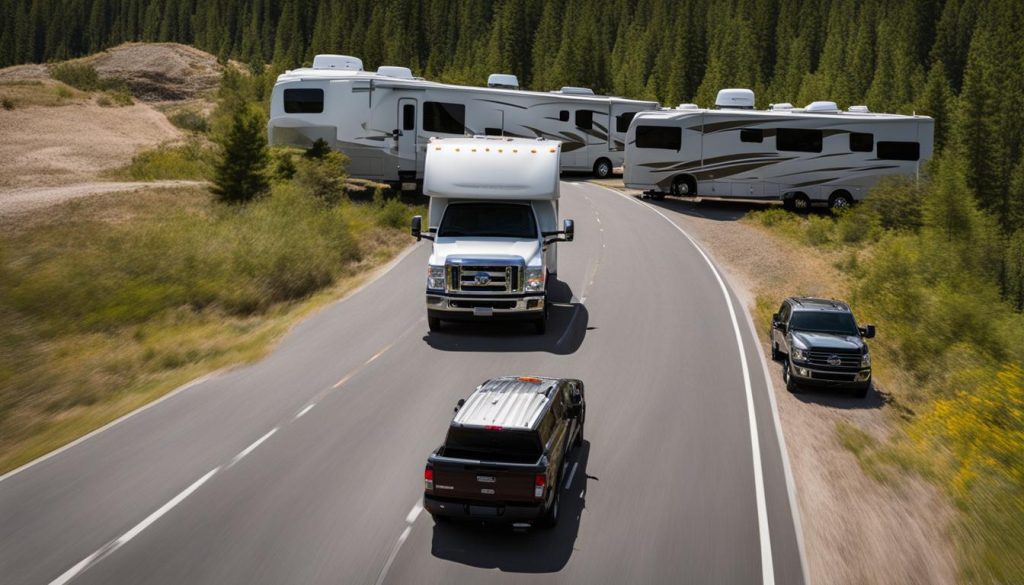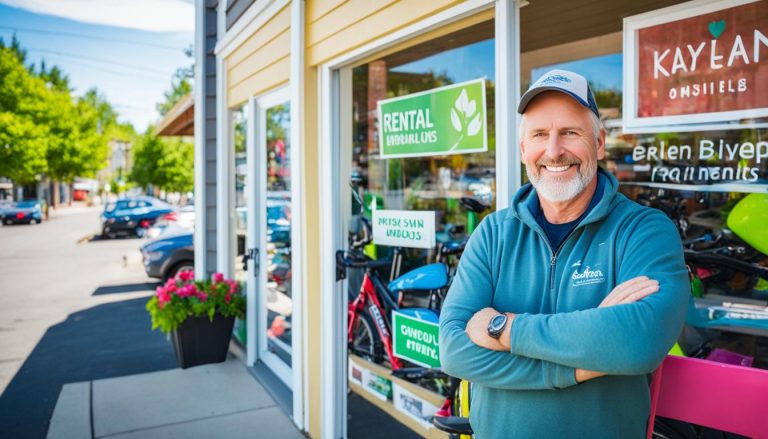Master How to Backup a RV Trailer – Quick Guide
gorvlifestyle.com and its partners may earn a commission if you purchase a product through one of our links
Backing up a RV trailer can be a daunting task, especially for beginners. However, with the right techniques and some practice, you can easily master this skill. In this quick guide, we will walk you through the steps to backup a RV trailer safely and effectively.
Key Takeaways:
- Hold the steering wheel at the 6 o’clock position for better control.
- Look over your shoulder for a better view of the trailer.
- Visualize your vehicle pushing the trailer to steer effectively.
- Make wide turns to avoid jackknifing.
- Practice in a large, empty parking lot to build confidence.
Tips for Backing Up a Trailer
Backing up a trailer can be a challenging task, but with the right techniques and practice, you can become a pro at maneuvering your RV trailer confidently. Here are some essential tips to make the process easier:
- Hold the steering wheel at the 6 o’clock position: When backing up, position your hands at the bottom of the steering wheel. This allows you to easily visualize and steer the trailer in the desired direction.
- Look over your shoulder for a better view: If your trailer blocks the rear window, glance over your shoulder to get a clearer view of the area behind you. This helps you avoid blind spots and ensures safer maneuvering.
- Think of your vehicle pushing the trailer: Instead of considering your vehicle and the trailer as a single unit, imagine your vehicle pushing the trailer from behind. This mental shift can make it easier to understand and predict the movement of the trailer.
- Make wide turns initially: When starting to back up, make wider turns to avoid jackknifing the trailer. Gradually decrease the angle of the turn as you become more comfortable and confident in your abilities.
- Correct excessive turns: If you find yourself making excessive turns or veering off track, don’t panic. Steer your tow vehicle in the same direction as the trailer to correct the alignment. If necessary, pull forward and try again.
By following these tips, you’ll improve your RV trailer backup techniques and be able to navigate tight spots and parking spaces with ease.
Benefits of Holding the Steering Wheel at the 6 o’clock Position
When holding the steering wheel at the 6 o’clock position, you have better control and visualization of the trailer’s movement. It allows you to easily judge the direction in which the trailer will go and make necessary adjustments. Holding the steering wheel at this position also helps you avoid oversteering and jackknifing the trailer.
Steering Corrections While Backing Up
| Issue | Correction |
|---|---|
| Excessive turns | Steer tow vehicle in the same direction as the trailer |
| Veering off track | Pull forward and try again |
Backing Up Different Types of Trailers
Backing up different types of trailers requires different techniques. Whether you’re maneuvering a small trailer or a travel trailer, understanding the specific adjustments and strategies can make the process smoother and more efficient.
Backing Up Small Trailers
When it comes to small trailers, their shorter length allows for faster swings during backup. To maintain control, it’s crucial to make small steering adjustments and reverse slowly. By taking your time and making gradual movements, you can ensure precise positioning and avoid any sudden jerks or misalignments.
Backing Up Travel Trailers
Travel trailers, on the other hand, are longer and less responsive to steering adjustments. When backing up a travel trailer, you need to make more exaggerated movements to achieve the desired outcome. Using tow mirrors can provide a better view of the trailer’s positioning, allowing you to make more precise adjustments.
Backing Up into a Driveway or Confined Space
Backing up a trailer into a driveway or a confined space can be challenging due to limited maneuvering space. However, you can use the edges of the driveway as visual guides to help position the trailer correctly. By aligning the trailer with the edges and taking it slow, you can carefully navigate the tight space and achieve the desired placement.
Utilizing Mirrors for Backup
When it comes to backing up a trailer, one of the most crucial tools at your disposal is the use of mirrors. When the rear view is obstructed by the trailer, mirrors become essential for safe maneuvering. By installing tow mirrors, you can extend the view of your existing side mirrors, providing you with a better perspective of the trailer’s movements.

When backing up using side mirrors, it’s important to go slow and consciously check both mirrors. Remember that the view through the mirrors will be mirrored as well, so it may feel disorienting at first. Take your time to adjust to the reversed perspective and practice consistently using the mirrors to gauge the trailer’s position and alignment.
One helpful technique when backing up using mirrors is to use the placement of your hand on the steering wheel as a guide. As mentioned earlier, holding the steering wheel at the 6 o’clock position allows you to easily visualize and steer the trailer in the desired direction. By observing the movement of your hand on the bottom of the steering wheel, you can determine the direction the trailer will go.
Remember, safety should always be a priority when backing up a trailer. Be sure to follow all recommended RV trailer backup safety precautions, such as maintaining awareness of your surroundings, utilizing mirrors effectively, and communicating with spotters if necessary.
| RV Trailer Reversing Techniques | Risk Factors | Safety Precautions |
|---|---|---|
| Using Mirrors | Obstructed rear view, disorienting mirrored image |
|
| Communicating with Spotters | Potential miscommunication, limited visibility |
|
| Practice and Patience | Inexperience, overcorrection |
|
Backing Up with a Spotter
Hiring a spotter while backing up your RV trailer can greatly enhance safety and ease the process, especially when facing challenging angles or attempting maneuvers on the passenger side. Clear and effective communication between the driver and spotter is essential to ensure a smooth operation.
The spotter can use hand gestures or verbal cues to relay instructions to the driver. Hand gestures are particularly useful in situations where verbal communication may be difficult due to distance or noise. Here are a few commonly used hand gestures:
- Extend hands towards themselves: This gesture indicates the spotter wants you to reverse the trailer.
- Bend hands to the right: This gesture signifies the spotter wants you to reverse and steer the trailer to the right.
- Twist hands to the left: This gesture indicates the spotter wants you to reverse and steer the trailer to the left.
- Stand straight: This gesture means you should reverse the trailer in a straight line.
- Form an X shape with hands: This gesture signals the spotter wants you to stop immediately.
By establishing clear communication and using hand gestures, the spotter can guide you with precision, ensuring your RV trailer is backed up safely and accurately.

Training and Practice
To become proficient at backing up a trailer, training and practice are essential. By enrolling in in-person RV driving schools, you can receive comprehensive instruction and personalized training using your own rig. These schools offer hands-on guidance from experienced instructors who can teach you proper techniques for backing up a trailer. Online courses are another convenient and affordable option that provide permanent access to course materials, allowing you to learn at your own pace.
If you prefer a more immersive experience, realistic driving simulators can help you get a feel for towing a trailer before getting behind the wheel of your own rig. These simulators recreate various driving scenarios, allowing you to practice backing up and maneuvering a trailer in a safe and controlled environment.
However, no matter which training method you choose, practice is the key to success. Finding a large, empty parking lot or open space to set up a practice course is highly recommended. This will give you ample room to practice different backing up techniques and refine your skills.
During practice sessions, consider using a spotter to provide guidance and feedback. A spotter can help you avoid obstacles and provide assistance when maneuvering a trailer in tight spaces. Clear communication and trust between the driver and the spotter are crucial for a successful backing up operation.
When practicing, remember to utilize the bottom of the steering wheel for steering. This technique involves placing your hand at the bottom of the steering wheel and making adjustments based on the direction you want the trailer to go. By utilizing this method and practicing regularly, you’ll gradually improve your backing up abilities and gain confidence in handling a RV trailer.
| Training Methods | Pros | Cons |
|---|---|---|
| In-person RV driving schools | Comprehensive instruction Personalized training Hands-on guidance |
May require travel Higher cost |
| Online courses | Convenient and flexible Affordable Permanent access to course materials |
Lack of physical practice Limited personal interaction |
| Realistic driving simulators | Safe and controlled environment Immersive experience Practice various scenarios |
May lack real-world feel Simulation limitations |
With dedicated training and regular practice, you’ll become more proficient at backing up a RV trailer. Remember to choose a training method that suits your needs and take advantage of the resources available to you. The more you practice, the more confident you’ll become in maneuvering and backing up your trailer.
Overcoming Challenges and Building Confidence
Backing up a trailer can be a daunting task, especially for beginners. Challenges such as overcorrecting, limited visibility, and the fear of jackknifing are common concerns. However, with practice, experience, and the right techniques, you can become proficient at backing up a trailer.
One key aspect of successful trailer backup is the use of mirrors and backup cameras. These tools provide valuable visibility and can help you better navigate tight spaces and avoid obstacles. Additionally, having a reliable spotter to guide you during the backing up process can greatly enhance your confidence and safety.
Building confidence in trailer backup takes time and patience. It’s crucial to take it slow and learn from small mistakes along the way. By gradually gaining experience and developing your skills, you’ll become more comfortable in handling the challenges that come with backing up a RV trailer.
Remember, practice makes perfect! Regularly set aside time to practice your trailer backup techniques in a controlled environment, such as an empty parking lot. By honing your skills and learning from each session, you’ll steadily build the confidence needed to handle any backing up situation with ease.
FAQ
How do I back up a trailer properly?
To back up a trailer properly, you should hold the steering wheel at the 6 o’clock position, look over your shoulder for a better view, visualize your vehicle pushing the trailer, make wide turns, and avoid jackknifing the trailer. Practice, patience, and gradually building confidence are also essential.
What tips can help me when backing up a trailer?
Some important tips for backing up a trailer include holding the steering wheel at the 6 o’clock position, looking over your shoulder for a better view, visualizing your vehicle pushing the trailer, making wide turns, and avoiding jackknifing the trailer.
How do I back up different types of trailers?
Backing up different types of trailers requires different techniques. For small trailers, it’s important to make small adjustments and reverse slowly. Travel trailers require more exaggerated movements and the use of tow mirrors for better visibility.
How do I use mirrors for backup?
When backing up, using mirrors becomes crucial for safe backup. Installing tow mirrors to extend the view of existing side mirrors is recommended. Go slowly and consistently check both mirrors to ensure a clear view.
How can a spotter help me when backing up a trailer?
Having a spotter while backing up a trailer can be extremely helpful, especially when dealing with difficult angles or backing up on the passenger side. Clear communication is essential, and hand gestures or shouting can be used to convey instructions.
How can I train and practice to become better at backing up a trailer?
Training and practice are essential for gaining confidence and skill in backing up a trailer. In-person RV driving schools, online courses, and realistic driving simulators are all options to consider. Regular practice with a spotter and utilizing the bottom of the steering wheel for steering will improve your abilities.
How can I overcome challenges and build confidence when backing up a trailer?
Backing up a trailer can be challenging, especially for beginners. With practice, experience, and the right techniques, anyone can become proficient. Using mirrors, backup cameras, and having a reliable spotter can help overcome challenges. Building confidence comes with time and practice.






